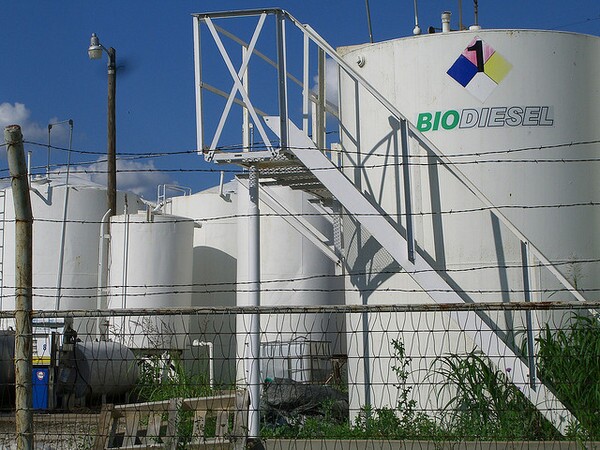American Cars and Trucks are Burning More Biofuels

Biodiesel service station in Fort Worth, Texas | Photo: Chris Dunphy/Flickr/Creative Commons License
Cars and trucks in the U.S. are running on gasoline with a higher proportion of ethanol these days, but limitations in older vehicles are likely to keep that percentage from growing much further, according to a report released today by the Energy Information Administration (EIA).
The report, Biofuels Issues and Trends, also notes that biodiesel use in the U.S. went up dramatically in 2011, more than tripling its contribution to the total diesel consumed in the U.S. in that one-year period.
Related

Transportation and Renewable Energy
In 2011, the percentage of ethanol additive as a total amount of gasoline consumed in the U.S. climbed to 9.6%, up from 9.3% in 2010 and 8.0% in 2009. That means that gasoline across the U.S. is very close to the maximum percentage of ethanol approved for use in all cars and light trucks: the "E10" blend, named after its 10% ethanol content.Ethanol fuel, chemically identical to the alcohol found in alcoholic drinks, is generally distilled from fermented agricultural products. In the U.S., that's generally corn. More than 10% ethanol in gasoline poses a risk of corrosion of parts in older vehicles, and it also requires upgrading tanks, nozzles and hoses at gasoline stations. E10 can be dispensed by existing gasoline stations without upgrades.
Still, a gasoline blend with more ethanol -- E15 -- has been approved for most newer cars, and it's technically feasible to raise that percentage much higher. Some gas stations already have "blending tanks" that can provide vehicles with ethanol blends ranging from 10% to 85% ethanol.
According to the EIA report, biodiesel -- a fuel made from plant and animal fats -- has grown dramatically in the last decade. Biodiesel production in 2011 was more than 100 times 2001's level. Still, biodiesel isn't nearly as close to pushing its "blend cap" as ethanol. Diesel fuel blends containing up to 5% biodiesel are approved for all diesel engines in the U.S., but the overall percentage in U.S. fuels -- even with the dramatic increase over the last decade -- is less than half that.
As ethanol and biodiesel are generally made from potentially edible crops, the industry has taken some criticism for adding to demand for those crops, raising food prices. A possible solution would be to extract biofuels from agricultural waste such as straw and corn stalks, but according to the report, not much has happened to advance so-called "cellulosic ethanol." Of four U.S. facilities built recently to produce cellulosic ethanol, three produced no fuel in 2011, and the fourth only produced a fraction of its capacity.
ReWire is dedicated to covering renewable energy in California. Keep in touch by liking us on Facebook, and help shape our editorial direction by taking this quick survey here.


